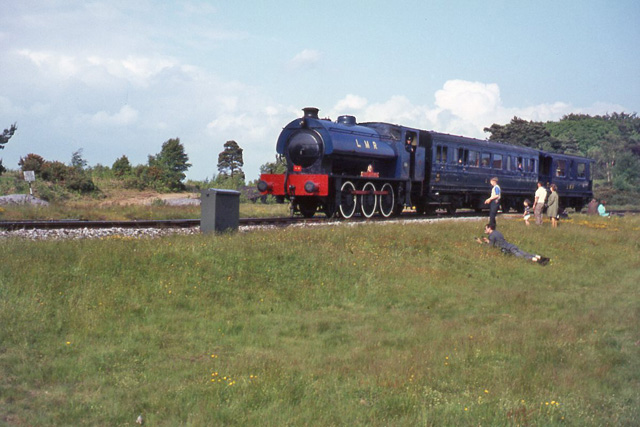|
GER Class C72
The GER Class C72 was a class of thirty steam locomotives designed by A. J. Hill for the Great Eastern Railway. They passed to the London and North Eastern Railway (LNER) at the 1923 grouping and received the LNER classification J68. History These locomotives were an improved version of the Class S56 tanks, and the final development of James Holden's Class T18 tank locomotives, sharing the same cylinders, driving wheels, and wheelbase. There were three orders, each of ten locomotives, all built at Stratford Works between 1912 and 1923. The first batch were built as suburban passenger tanks and were fitted with Westinghouse air brakes. The second and third batches were built as shunting tanks and were fitted with steam locomotive brakes and vacuum train brakes. The last batch did not emerge from Stratford until after the grouping. One locomotive was lent to the War Department in October 1939, and sold 12 months later,. It was used on the Longmoor Military Railway ... [...More Info...] [...Related Items...] OR: [Wikipedia] [Google] [Baidu] |
Stratford Works
Stratford Works was the locomotive-building works of the Great Eastern Railway situated at Stratford, London, England. The original site of the works was located in the 'V' between the Great Eastern Main Line and the Stratford to Lea Bridge route and in the early years was also the home of Stratford Locomotive Depot. The final part of the works closed in 1991. Overall Stratford works built 1,702 locomotives; 5,500 passenger vehicles and 33,000 goods wagons (although a significant number of these were built at the nearby Temple Mills wagon works when wagon building moved from the Stratford site in 1896). History Early history (1840-1862) Activity on the site was started in 1840 by the Northern and Eastern Railway who had opened a new line that joined the Eastern Counties Railway at Stratford. The locomotives were maintained at a roundhouse called the Polygon which was built between July and September 1840 to a design by Robert Stephenson (a surviving example of which can be ... [...More Info...] [...Related Items...] OR: [Wikipedia] [Google] [Baidu] |
Longmoor Military Railway
The Longmoor Military Railway (LMR) was a British military railway in Hampshire, built by the Royal Engineers from 1903 in order to train soldiers on railway construction and operations. The railway ceased operation on 31 October 1969. Route Authorised for construction from 1902, activities date from 1903 when an gauge tramway was laid to assist in removing 68 large corrugated iron huts from Longmoor Military Camp to Bordon. The railway was relaid to standard gauge in 1905–1907 and was initially known as the Woolmer Instructional Military Railway. It was renamed the ''Longmoor Military Railway'' in 1935. The Liss extension was opened in 1933. The stations and junctions included: *Bordon – the northern terminal, adjacent to Bordon station and with access to British Railways via the LSWR owned Bentley and Bordon Light Railway. * Oakhanger Halt - serving the village of Oakhanger, Hampshire. Bordon station was nearer to Oakhanger and Oakhanger station was nearer to Bordon ... [...More Info...] [...Related Items...] OR: [Wikipedia] [Google] [Baidu] |
Scrapped Locomotives
Scrap consists of recyclable materials, usually metals, left over from product manufacturing and consumption, such as parts of vehicles, building supplies, and surplus materials. Unlike waste, scrap has monetary value, especially recovered metals, and non-metallic materials are also recovered for recycling. Once collected, the materials are sorted into types — typically metal scrap will be crushed, shredded, and sorted using mechanical processes. Scrap recycling is important for creating a more sustainable economy or creating a circular economy, using significantly less energy and having far less environmental impact than producing metal from ore. Metal recycling, especially of structural steel, ships, used manufactured goods, such as vehicles and white goods, is a major industrial activity with complex networks of wrecking yards, sorting facilities and recycling plants. Processing Scrap metal originates both in business and residential environments. Typically a "scrapper" ... [...More Info...] [...Related Items...] OR: [Wikipedia] [Google] [Baidu] |
War Department Locomotives
War is an intense armed conflict between states, governments, societies, or paramilitary groups such as mercenaries, insurgents, and militias. It is generally characterized by extreme violence, destruction, and mortality, using regular or irregular military forces. Warfare refers to the common activities and characteristics of types of war, or of wars in general. Total war is warfare that is not restricted to purely legitimate military targets, and can result in massive civilian or other non-combatant suffering and casualties. While some war studies scholars consider war a universal and ancestral aspect of human nature, others argue it is a result of specific socio-cultural, economic or ecological circumstances. Etymology The English word ''war'' derives from the 11th-century Old English words ''wyrre'' and ''werre'', from Old French ''werre'' (also ''guerre'' as in modern French), in turn from the Frankish *''werra'', ultimately deriving from the Proto-Germanic *''we ... [...More Info...] [...Related Items...] OR: [Wikipedia] [Google] [Baidu] |



